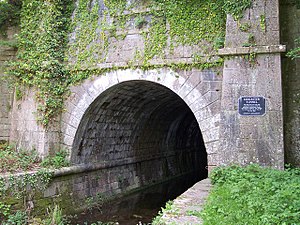Hincaster Tunnel
The Hincaster Tunnel is a canal tunnel in Westmorland, on the Lancaster Canal; the only tunnel on the canal. It is part of the east-west link by which the canal passes the hills to reach the dale of the River Kent, whence it once reached as far north as Kendal.
The canal was brought through Hincaster to serve the Wakefield Gunpowder Works at Sedgwick.
The tunnel is 378 yards long, and was opened for use on 18 June 1819.
Contents
History
The Hincaster Tunnel is the only tunnel on the Lancaster Canal. It was built to take barges close to Sedgewick Gunpowder Works. The tunnel has no towpath so the barges were hauled through by means of a rope fixed on a sidewall, or were 'legged' through by the boatmen, by pushing against the tunnel sides with their feet. The horses were led over the tunnel along the horse path, which is a noted feature today, and indeed a listed structure in itself, and the route followed by ramblers walking the canal.
The building of Hincaster tunnel removed the major obstacle on the northern section of the canal. Faced with limestone, 378 yards, it is lined with something like four million bricks. The bricks were made from clay dug at Mosside Farm, on the canalside about half a mile south of Milness, by the present A65. On 4 February 1817, it was reported that 'two million bricks had been made and half the length of the tunnel completed'.[1]
Horse path
The Hincaster Tunnel horse path leads away from the canalside, up and over the hill beneath which the Hincaster Tunnel bores. At the mouth of the tunnel, towing horses would have to be unhitched from their barges, which would enter the darkness of the tunnel alone, legged along its 378-yard length until they emerged once more into the light. The path is reasonably well-preserved and today has the status of a listed structure.[2][3]
The horse path which stretches from 197 feet south-east to a place 410 yards east of Canal Cottage.
The path was listed as a part of the wider remains of Lancaster Canal and because it provides insight into the varied engineering responses required to carry water ways through varied terrain.
Outside links
| ("Wikimedia Commons" has material about Hincaster Tunnel) |
References
- ↑ The Hincaster Tunnel by 'The Piddler'
- ↑ National Heritage List 1004594: Hincaster Tunnel horse path
- ↑ National Monuments Record: No. 43111 – Hincaster Tunnel horse path
